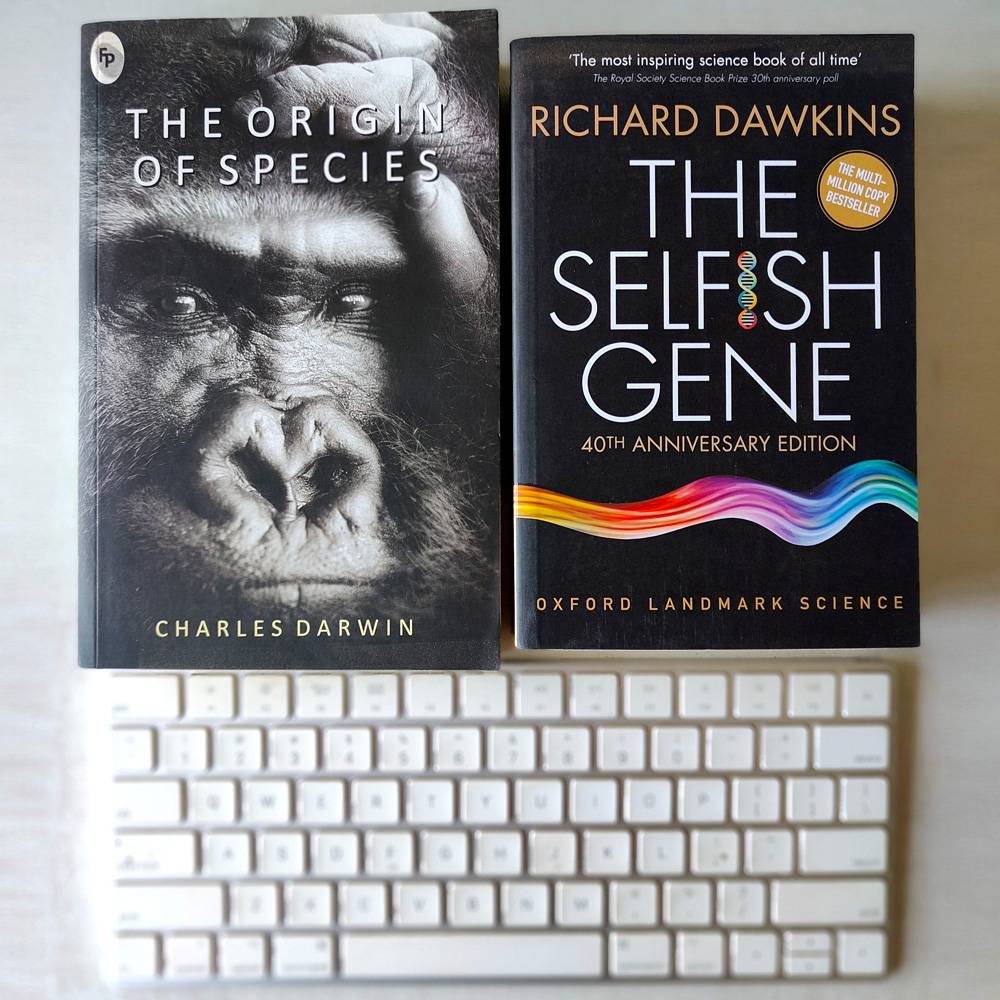
07 Apr To Gene or To Meme, That is the question
The idea of evolution of our species has always tickled my fancy. The thought of having monkey ancestors is both comforting and disconcerting, but regardless of whether or not this is actually true, most people seem to be chuffed with the idea. The very word ‘Evolution’ is almost synonymous with progress, growth, and all the other bits and bobs that make our lives unique and interesting. So, it may be in our interest to understand how we can evolve efficiently in our lifetimes, and perhaps also ensure evolution is efficient for our future generations. Is it even possible to make an attempt towards making evolution a controlled and calibrated process? The idea of evolution must tickle our fancy, wouldn’t you agree?
Let’s begin from the time when evolution started to come into the control of the scientific community from the hands of the religious community. In 1859, Charles Darwin‘s theory of evolution by natural selection, as outlined in his seminal work “The Origin of Species,” was published and since then it has become the cornerstone of modern biology. The basic idea is that genes are transmitted from one generation to the next, and those that confer a reproductive advantage are more likely to be passed on. But, as any self-respecting scientist would tell you, the role of genes in human evolution has been overshadowed by another factor. Yes, you got me right! Let’s explore.
In 1976, biologist Richard Dawkins coined the term “meme” in his book “The Selfish Gene“. Memes refer to cultural units of information, such as beliefs, ideas, and behaviours, that are transmitted from one person to another. Just as genes compete for survival and reproduction, so do memes. Those memes that survive are more successful at replicating themselves and more likely to be passed on. Aha, do you often get forwards, shares, mailers, etc. on your digital accounts?!
While genetic adaptation used to be the primary driver of evolution, it takes donkey years and multiple generations for a new genetic trait to become widespread in a population. Memes, on the other hand, can spread within a few hours like wildfire. An idea or cultural practice can go viral in a matter of days or weeks, perhaps hours too, thanks to channels like language, music, art, and the powerful internet. And not to forget how memes can also quickly adapt and get modified to changing social and environmental conditions much more rapidly than genes can.
Thus, it is interesting to contemplate the role of memes over genes as means of evolution of our species. Blimey, it turns out that memes, those sneaky little cultural units of information, may have an even bigger impact on our evolution than good old-fashioned genes. Who would have thought?!
An intriguing aspect of memes is their ability to create new forms of social organisation. They bring people together and create new forms of identity and social connections, as followers, subscribers, patrons, etc. Unlike genes which are based on competition of ‘survival of the fittest’, memes propagate by ‘popularity by sharing and collaborations’. Social media has led to the creation of online communities and to the rampant development of new forms of social awareness and activism.
The tacit truth is memes are not just a reflection of our culture; they also shape it in some pretty significant ways. Just look at the examples of how the spread of certain ideas, i.e. memes, has led to changes in social norms, beliefs, and values… and is this change inadvertently affecting our genes too!
- Through the meme that smoking is harmful, we’ve seen a huge decline in smoking rates over the years. And that means healthier lungs, healthier organs, and healthier genes to pass on!
- Because of memes on recycling being important, we’ve witnessed a significant shift in our behaviour towards pollution control and waste management. Less pollution, and consequently, fewer diseases means our genes get the chance to evolve in a healthier direction!
- Again, thanks to the dominance of memes on education and cultural nuances, we’ve witnessed a shift in behaviour and choices regarding our relationships, even marriages, based on meme-pedigree (i.e. educational and cultural background) instead of gene-pedigree (i.e. physical features and health markers of an individual and their family’s gotra).
- Memes have played a big part in highlighting that diversity is more important than uniformity. We’ve seen changes in laws and social acceptance of inter-caste and inter-culture unions and migrations. This inter-mixing may benefit survival by imbibing the best from different genes and passing it on to the next generation, leading to better physical as well as mental health outcomes!
- Not to miss is that memes have promoted individuality and personal preferences also. Lately, world over we have greater acceptance of LGBTQ and same-sex biological partnerships. This might be a positive change for society since it promotes equal rights and acceptance.
So, should this make us wonder whether gene-research is a bit overrated?
Nah! Genes still play a critical role in human evolution, governing our physical characteristics and biological traits in areas of health and disease. We can not yet put down the test tubes once and for all, and pick up the meme scrolls instead. Gene-scientists are trying to find the switch in our genetic code that can put diseases like cancer off. But, maybe we need to start thinking, researching, and learning more about the cultural practices and institutions that can promote things like survival, sustainability, social justice, and mental health, rather than relying too much on fancy technology or playing around with our genetic code (CRISPR*).
The rapid pace of cultural evolution driven by memes means that many aspects of human behaviour, such as our dietary preferences, social norms, friendships, professions, fashion, sustainability, and even our sense of identity, maybe more strongly influenced by memes, and not as much by genes. As memes influence these behaviours and choices, they indirectly affect the quality of our genes over our lifetimes, and for future generations.
Could it be that social structures created in our society are a meme-fication process to bring genetic change in sects of people and communities? Social structures and organisations live by defined codes and laws. Perhaps, the repeated practice of certain codes over generations can lead to genetic prowess in a domain. Perhaps, in absence of rapid growth of memes in earlier times, the caste systems helped develop stronger genes over generations in the four aspects of society – knowledge (brahmins), governance (kshatriyas), trade (vaishyas), and workmanship (shudras)!
Are genes and memes contradictory in their approach toward evolution?
As for whether gene evolution and meme evolution conflict with each other, the answer perhaps is both yes and no. The approach for evolution in each of them is based on two different fundamentals: ‘survival’ and ‘exploration’. Gene evolution is primarily dominated by ‘survival’, and thus is risk-averse for its existence. Meme evolution is based on ‘exploration’, thus it embraces risk for creating newness. This inherent difference between genes and memes can sometimes cause a conflict between the two. As Shakespeare might have phrased it, the question boils down to, “To risk or not to risk? Whether it is nobler to evolve slowly and steadily through genes, or to forge ahead quickly with memes?” That is the question.
Why not have both in our armour?
Well, we are continuously trained to live in a binary world that is risk-averse. More people tend to make binary choices such as ‘yes, no’, ‘either, or’, ‘us, them’, etc., because binary is simpler for our decision-making and often has a bias towards survival above all. Perhaps, it may be beneficial to tread the complexities in the realm of neither black nor white, but grays. A conscious interaction of genes and memes can lead to the emergence of new traits and behaviours that can strike a balance in this ‘grayness’, ultimately shaping the evolutionary trajectory of our species not only for ‘survival of the fittest’ but also for ‘evolution by collaborations’. As we progress, it becomes essential to not only invest ourselves in ‘gene research’ but also be consciously invested in ‘meme research’. Because… evolution by memes is much faster and controllable than evolution by genes.
In summary, as we face the speed of the 21st century, memes are becoming the primary drivers of human behaviour in our lifetimes as well as for the future generations. Our ability to shape and control memes is crucial for our long term well being. We are shaping the future of humanity with every click of the “Share” button. Therefore, should we be more mindful of the memes we make, consume and share? Will it be better if memes are governed and regulated by laws that are fair to societies and not run by the whim and fancy of individuals? Or, can we trust our evolution on auto mode, via unregulated channels like social media? Perhaps, AI can decide this for us. Eh?!
*CRISPR
CRISPR (pronounced “crisper”) is a revolutionary gene-editing technology that allows scientists to selectively modify the DNA of living organisms, including plants, animals, and even humans.
The CRISPR gene-editing technology was first introduced as a revolutionary tool for genetic engineering in 2012. Jennifer Doudna and Emmanuelle Charpentier, two researchers from the University of California, Berkeley, and the University of Vienna, respectively, were credited with the groundbreaking discovery. In a seminal paper published in the journal Science in June 2012, they described how they harnessed the CRISPR-Cas9 system to edit DNA with unprecedented precision and efficiency.
The discovery of CRISPR as a versatile and efficient gene-editing tool has rapidly transformed the field of molecular biology and genetic research. Since its introduction, CRISPR has been widely adopted in laboratories around the world, and it has opened up new possibilities for editing genes in a wide range of organisms, including plants, animals, and humans. The development of CRISPR has led to significant advancements in areas such as gene therapy, agriculture, and drug discovery, and it continues to be an active area of research and development with the potential for numerous applications in the future.
However, the ethical implications of using CRISPR on humans and the potential for unintended consequences in altering the genetic makeup of organisms are still subjects of ongoing debate and research.
P.S.: If you liked this post, then you may consider reading Roti Kapda Makaan – The modern context, Keeping Tabs , and Attention Economy & Attention Syndrome also



No Comments